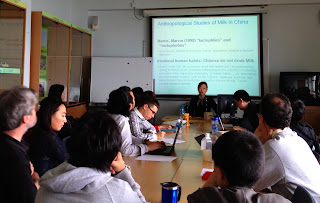Part-time Lecturer, Department of Anthropology, CUHK
"Globalization of Milk: Milk and Modernity in South China"
23 Nov 2012
 It was interesting to listen to Dr. Mak’s talk a week after Sidney Mintz had received the Franz Boas Award for Exemplary Service to Anthropology at the 2012 American Anthropological Association Meeting. His “Sweetness and Power” is an influential book in the discipline that has provided a new perspective on food studies in the global context. Dr. Mak’s study was clearly inspired by this approach. Her presentation “Globalization of Milk: Milk and Modernity in South China” focused on the production and consumption of cow’s milk in Shunde, South China, illustrating the continuation and reinvention of tradition under globalization, identity construction, and the building of modern state.
It was interesting to listen to Dr. Mak’s talk a week after Sidney Mintz had received the Franz Boas Award for Exemplary Service to Anthropology at the 2012 American Anthropological Association Meeting. His “Sweetness and Power” is an influential book in the discipline that has provided a new perspective on food studies in the global context. Dr. Mak’s study was clearly inspired by this approach. Her presentation “Globalization of Milk: Milk and Modernity in South China” focused on the production and consumption of cow’s milk in Shunde, South China, illustrating the continuation and reinvention of tradition under globalization, identity construction, and the building of modern state.Firstly, Dr. Mak pointed out the common impression that milk was a newly accepted food in the “modernized” China was wrong. Indeed, the consumption and production of milk in China did increase dramatically over the recent decades, cow milk nonetheless has had a long history in China, often being used as medicine. For example, in Daliang, a town of Shunde, the use and production of buffalo milk had long developed due to the prosperity of local industries such as silk and paper production, which, similar to buffalo raising, needed a lot of water.
However, after the establishment of the People’s Republic of China, the collectivization of buffalos and the state-imposed division of labor hit the local milk production badly. The open-up reform and urbanization has further marginalized the buffalo raising since the 1980s.
Interestingly, buffalo milk played an important role in Shunde again in the global era. Buffalo milk has become an important part of the local identities. It was popular among Shunde people to bring friends to the reinvented, yet “authentic” buffalo milk cuisine and showcase their knowledge of the cuisine and food rituals; migrant workers from this area regarded Daliang buffalo cheese as nostalgic food, which contributed to a stable demand for the good; merchants, such as the one who invented instant double-layered milk powder, seized the economic opportunities of branding the buffalo milk culture as souvenirs of the place. The state and the local government also took shares by building up culinary heritage and national pride.
Gloria TSANG
M.Phil. Candidate

No comments:
Post a Comment